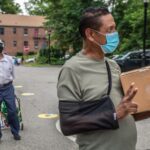Refugee-led organisations (RLOs) fill public health assistance gaps during COVID-19. Refugees do and can provide public health information and supplement capacity gaps. Refugees do and can deliver healthcare, shape social norms, track viruses/contacts. Mechanisms are needed to identify RLOs, offer funding, and build their capacities. The COVID-19 pandemic and ensuing socioeconomic impact on already marginalised refugee communities demonstrate both the need for, and lack of, localisation in humanitarian and development responses. Our research with organisations founded and led by refugees, termed here refugee-led organisations (RLOs), in camps and cities in Kenya and Uganda shows their potential to be an asset in the response to COVID-19 and in contributing to more effective and participatory forms of humanitarian assistance. In this research note we draw on pre-pandemic research with around 80 RLOs and follow-up research with 15 in Uganda and Kenya who are actively responding to the pandemic and its effects. We identify five key areas in which refugees are or could be involved as responders to COVID-19 and other pandemics: providing public information, supplementing capacity gaps, healthcare delivery, shaping social norms, and virus tracking and contact tracing. Our research during COVID-19 shows how RLOs have pivoted their existing service provision to fill assistance gaps, including in areas directly related to public health. As the humanitarian system searches for ways to implement remote and participatory approaches to refugee assistance, RLOs offer great potential, if mechanisms can be found to identify those that are effective, provide them with funding, and build their capacities.
The management of volunteers – What can human resources do? A review and research agenda
There is an increasing interest from scholars and practitioners in understanding how non-profit organizations can design and implement human resources (HR) practices to enhance desirable volunteer attitudes and behaviors. This paper presents a comprehensive overview of existing studies on the relationship between HR practices and volunteering outcomes. We use the ability-motivation-opportunity model as a guiding…

